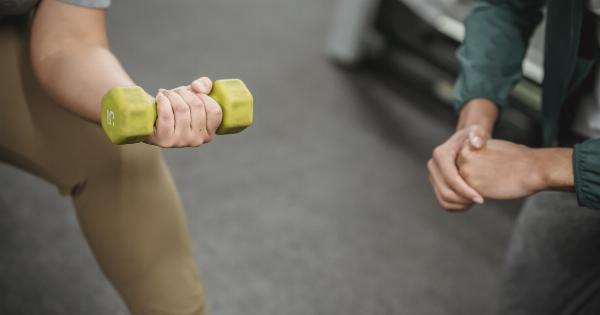Inflammation is the body’s immune system response to injury, stress, or infection. It is a necessary process for healing and fighting off pathogens, but it can also become chronic and contribute to various health problems.
Chronic inflammation has been linked to many conditions, including heart disease, diabetes, and cancer. On the other hand, cravings are intense desires for specific foods, usually high in sugar and unhealthy fats.
Cravings are usually associated with emotional eating, hormonal imbalances or nutritional deficiencies, which can contribute to chronic inflammation. While there are several ways to reduce inflammation and cravings, exercises can be an effective strategy. In this article, we will discuss some exercises you can do to reduce inflammation and cravings.
1. Aerobic Exercises
Aerobic exercises are activities that increase your heart rate and breathing, such as running, swimming, or cycling.
These types of exercises are great for reducing inflammation and cravings because they stimulate the production of anti-inflammatory cytokines, which help fight inflammation. They also help regulate blood sugar levels and increase insulin sensitivity, which can help reduce cravings. Aim for at least 30 minutes of moderate-intensity aerobic exercise, such as brisk walking, five days a week.
2. High-Intensity Interval Training (HIIT)
HIIT is a type of exercise that involves short bursts of intense activity followed by short periods of rest or active recovery. This type of exercise has been shown to reduce inflammation and improve insulin sensitivity, leading to reduced cravings.
HIIT workouts can be done in a short amount of time, making them a great option for those with a busy schedule. Try incorporating some HIIT workouts, such as sprints or burpees, into your weekly routine.
3. Yoga
Yoga is a mind-body practice that involves physical poses, breathing exercises, and meditation. Yoga has been shown to reduce inflammation and stress, two factors that contribute to cravings.
Stress can lead to emotional eating, which can cause long-term inflammation in the body. Yoga can help reduce stress and promote mindfulness, which can reduce the likelihood of emotional eating. Try attending a few yoga classes a week or starting your day with a quick yoga routine.
4. Resistance Training
Resistance training involves using weights or bodyweight to build strength and muscle. This type of exercise has been shown to reduce inflammation and improve insulin sensitivity, which can help reduce cravings.
Resistance training can also improve body composition, leading to a healthier weight and reduced risk of chronic inflammation. Try incorporating some resistance training into your workout routine, such as squats, push-ups or lunges.
5. Tai Chi
Tai chi is a low-impact form of exercise that involves slow, gentle movements and deep breathing. Tai chi has been shown to reduce inflammation and stress, which can lead to reduced cravings.
The slow, controlled movements of tai chi can help increase body awareness and promote mindfulness, which can help reduce emotional eating. Try attending a tai chi class or finding some beginner tai chi routines online.
6. Walking
Walking is a simple and effective way to reduce inflammation and cravings. Walking at a moderate pace can stimulate the production of anti-inflammatory cytokines, which can help reduce chronic inflammation in the body.
Walking can also help regulate blood sugar levels, leading to reduced cravings. Try fitting in a brisk walk during your lunch break or taking a stroll after dinner.
7. Swimming
Swimming is a low-impact form of exercise that can reduce inflammation and cravings. Swimming can reduce joint pain and improve flexibility, making it a great option for those with arthritis or other joint conditions.
Swimming also helps regulate blood sugar levels and improve insulin sensitivity, leading to reduced cravings. Try incorporating some laps at your local pool into your workout routine.
8. Pilates
Pilates is a type of exercise that focuses on building strength and flexibility through controlled movements. Pilates has been shown to reduce inflammation and stress, two factors that contribute to cravings.
Pilates can also improve posture and reduce the risk of injury, making it a great option for those with back pain or other injuries. Try attending a few Pilates classes or finding some beginner Pilates routines online.
9. Dancing
Dancing is a fun and effective way to reduce inflammation and cravings. Dancing can increase heart rate and blood flow, leading to increased production of anti-inflammatory cytokines.
Dancing can also improve mood and reduce stress, which can lead to reduced emotional eating. Try attending a dance class or dancing around your living room to your favorite songs.
10. Stretching
Stretching is a simple and effective way to reduce inflammation and cravings. Stretching can improve flexibility and reduce muscle tension, leading to reduced joint pain and inflammation.
Stretching can also promote relaxation and reduce stress, which can reduce emotional eating. Try incorporating some stretching into your daily routine, such as stretching before bed or during commercial breaks.
Conclusion
Exercises are a great way to reduce inflammation and cravings.
Aerobic exercises, HIIT, Yoga, resistance training, Tai chi, walking, swimming, Pilates, dancing, and stretching are all effective exercises to include in your routine to help reduce inflammation and cravings. Keep in mind that consistency is key when it comes to exercise. Start with small goals and gradually work your way up to longer workouts and more challenging exercises.
Along with exercises, make sure you are eating a healthy, balanced diet and getting enough sleep to support your overall health and well-being.





























